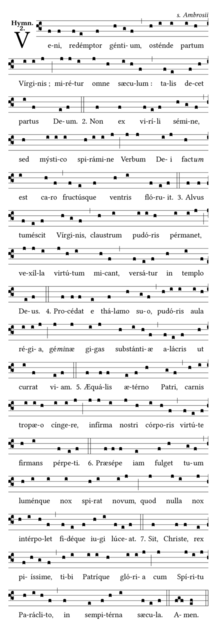Veni redemptor gentium
Veni redemptor gentium, Kom världens frälsare, är en latinsk adventspsalm av Ambrosius av Milano.[1] [2]
Historia
Den senare hymnen Veni Creator Spiritus lånar två rader från hymnen Infirma nostri corporis — Virtute firmans perpeti. "Veni redemptor gentium" var särskilt populär i Tyskland och Martin Luther överstte den till tyska som Nun komm, der Heiden Heiland, som han senare satte som korla, eller möjligen Johann Walter. [3] Luther använde origalhymnen till tre andra psalmer: "Verleih uns Frieden gnädiglich", "Erhalt uns, Herr, bei deinem Wort" och "Gib unserm Fürsten und aller Obrigkeit".
I mitten av 1800-talet översatte John Mason Neale hymnen till Engelska som "Come, thou Redeemer of the earth". Den sjungs ofta till melodin "Puer nobis nascitur" av Michael Praetorius.
Text
| Latin | English |
|---|---|
1. Veni, redemptor gentium; |
Come, thou Redeemer of the earth, |
2. Non ex virili semine, |
Begotten of no human will, |
3. Alvus tumescit Virginis, |
The virgin womb that burden gained |
4. Procedens de thalamo suo, |
Forth from His chamber goeth He, |
5. Egressus ejus a Patre, |
From God the Father He proceeds, |
6. Aequalis eterno Patri, |
O equal to the Father, Thou! |
7. Presepe jam fulget tuum, |
Thy cradle here shall glitter bright |
The metrical English translation was made by J. M. Neale.
Källor
</references>
- ↑ Christine Mohrmann Études sur le latin des chrétiens, vol. I, Le latin des chrétiens - Page 167 "Pour illustrer ce que j'ai dit, je citerai deux strophes de l'hymne de Noël de saint Ambroise, intitulé: Veni redemptor gentium: Veni redemptor gentium Ostende partum virginis Miretur omne saeculum Talis decet partus Deum. J'ai fait observer ...
- ↑ Hymnal Noted, Pt. I (John Mason Neale and Rev. Thomas Helmore, eds.), London: Novello & Co., 1856, #12, pp. 35-36
- ↑ Paul Westermeyer Let the People Sing: Hymn Tunes in Perspective 2005 Page 61 "Advent Ambrose's Advent hymn "Veni redemptor gentium," discussed in Chapter II, was well known in Germany. Luther translated it into German. Then he, or possibly Walter, simplified its chant tune, VENI REDEMPTOR GENTIUM, into the chorale tune that takes its German name from Luther's translation, NUN KOMM, DER HEIDEN HEILAND." For a comparison of the chorale tune to the original chant melody, see "Chorale Melodies used in Bach's Vocal Works: Nun komm, der Heiden Heiland," Bach Cantatas Website, accessed 2014-08-27.
